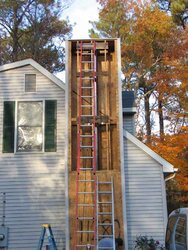Can I get some detailed information for what chase requirements are?
The lower 8 feet or so of my chase are insulated, but there is no firebreak or anything in the chase. Above 8 feet, there is nothing except 2x4s with siding nailed directly to them.
What do I need to do to this to make it safe?
The county where I live is treating my install as an appliance change, so there are no permits or inspections needed. I talked to my insurance company about my installation, and they didn't care much either. I was told as long as I followed my inserts manufacturing instructions, I was OK. The instructions aren't very demanding, and I want to make my installation as safe as possible.
I have a Napoleon NZ26 zero clearance fireplace and duraplus chimney pipe (the triple wall, insulated stuff).
thanks.
The lower 8 feet or so of my chase are insulated, but there is no firebreak or anything in the chase. Above 8 feet, there is nothing except 2x4s with siding nailed directly to them.
What do I need to do to this to make it safe?
The county where I live is treating my install as an appliance change, so there are no permits or inspections needed. I talked to my insurance company about my installation, and they didn't care much either. I was told as long as I followed my inserts manufacturing instructions, I was OK. The instructions aren't very demanding, and I want to make my installation as safe as possible.
I have a Napoleon NZ26 zero clearance fireplace and duraplus chimney pipe (the triple wall, insulated stuff).
thanks.



